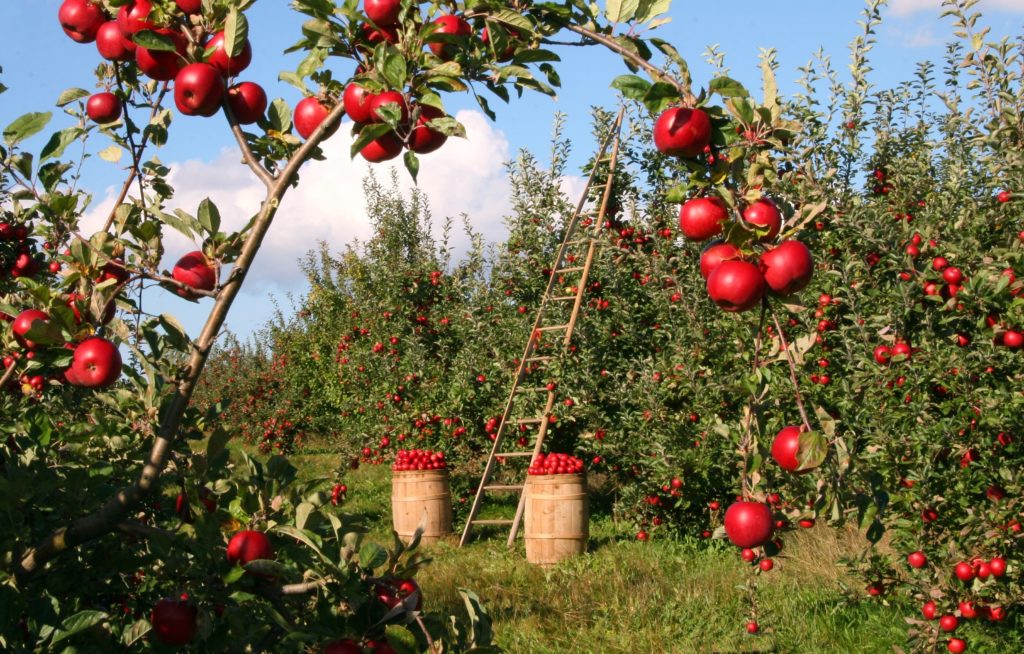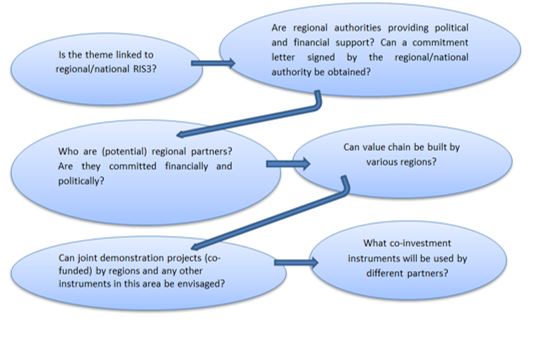Interregional cooperation in agri-food smart specialisation

DOI reference: 10.1080/13673882.2018.00001021
By Katerina Ciampi Stancova, PhD, European Commission’s Joint Research Centre, Seville, Spain
This insights article explores the European Commission’s Thematic Smart Specialisation Platform on Agri-food. First discussing the background to the initiative, Katerina Ciampi Stancova goes onto outline the criteria for successful submissions to the initiative and the potential benefits the scheme can bring to collaborating European regions.
Objectives of the Thematic Smart Specialisation Platform on Agri-food
Quadruple helix collaboration (industry-universities-government-civil society links) and collaboration within global value chains (GVCs) are central to smart specialisation. Collaboration provides an opportunity to create ‘alliances’ with stakeholders and among the regions in areas of common interest. Moreover, collaboration helps regions and countries build critical mass, join or complement missing resources as well as improve and build new production capacities. In other words, collaboration helps regions to improve their eco-systems, address weaknesses such as insufficient production resources and lack of specific knowledge, capacities or infrastructure.
The objective of the Thematic Smart Specialisation Platform on Agri-food (S3P Agri-food) is to accelerate the development of joint co-investment projects by encouraging and supporting interregional cooperation in thematic areas based on smart specialisation priorities linked to agriculture and food. The Thematic Smart Specialisation Platform on Agri-food brings together regional partnerships for interregional cooperation to boost investments in the Agri-food value chains using existing funding instruments. The S3P Agri-food Platform has very concrete objectives that differ significantly from those of other EU initiatives and platforms: it seeks to create an investment pipeline for mature projects in new growth areas linked to regional or national Smart Specialisation Strategies (RIS3), by providing tailored advice and helping regions establish links with business, research and civil society.
S3P Agri-food was launched in June 2016, during the Smart Regions conference, and it counts the support of DG AGRI, DG JRC, DG REGIO and DG RTD. The development and progress of the S3P Agri-food Platform is depicted in the figure 1. From June 2016 to December 2018, five partnerships qualified. Each existing Partnership has its own dedicated webpage hosted by the S3 Platform website:
- Consumer involvement in agri-food innovation (leading regions: Province of Gelderland, The Netherlands and Östergötland, Sweden)
- High-tech farming (leading region: Tuscany, Italy)
- Nutritional Ingredients (leading regions: Wallonia and Flanders, Belgium)
- Smart sensors for agri-food (leading regions: Flanders and Wallonia, Belgium)
- Traceability and Big Data (leading regions: Andalusia, Spain and Emilia-Romagna, Italy)
Figure 1. The development and progress of the AF Platform

Source: AF WCM – Agri-food Working Committee Meeting, EWRC – European Week of Regions and Cities
A total of 49 territorial administrative units have committed to participate in one of five existing Agri-food Partnerships (figure 2). Estonia and Austria are two EU countries that have joined the Agri-food Partnerships at the national level. In particular, four administrative units take part in the Consumer Involvement in Agri-food Innovation, 26 administrative units in High-tech Farming, 10 administrative units in Nutritional Ingredients, 13 administrative units in Smart sensors for Agri-food, and 20 in Traceability and Big Data. The majority of participating entities are located in Italy (9), Spain (8), France (4), Hungary (4) and the Netherlands (4). Some of these participate in more than one partnership; for example Galicia participates in 4 out of 5 partnerships. Furthermore, one non-EU region from Turkey (Middle Black Sea Region) is taking part in the Traceability and Big Data partnership.
Figure 2. Thematic Smart Specialisation Platform on Agri-food as of December 2018.

Reding Key: Blue colour – lead regions; yellow colour – regions participating in one or more partnership
Starting an Agri-food Partnership
The beginning of each Partnership is linked to national or regional RIS3 strategies. In practice though, regions interested in setting up a new Partnership should have a clear idea about how the topic they are proposing for interregional cooperation is related to their national and regional RIS3 strategy, policy mix, RIS3 instruments and planned investments. They should also have the ambition to improve their position within global value chains. Thematic Smart Specialisation Platforms are based on a bottom-up approach and the Partnerships are thus initiated, developed, sustained and led by regions, with the active participation of business organisations, research institutions, academia and civil society (quadruple helix partners).
The process of setting up a new Partnership begins with an assessment of interregional cooperation opportunities based on an analysis of similar and complementary smart specialisation priorities. The best way to go about this is to map existing or previous interregional collaboration in terms of research and innovation activities and outputs. Collaborations aimed at commercialisation of innovative products and services may take the form of patents or of co-authored academic publications. In order to get a thorough understanding of interregional linkages, data from numerous databases can be explored, including Cordis, OECD patent database (REGPAT), KEEP, bibliometric data (SCOPUS), ORBIS, etc. It is also essential to understand what exactly local stakeholders offer, as well as demand, in terms of technologies, knowledge, services, capacities and capabilities. Finally, analysis of global value chains is essential to understand the current situation and define desirable change. In sum, mapping of formal and informal networks, positioning within global value chains, flows of goods and services, as well as cooperation in Research and Innovation (R&I) projects, helps regions to identify and consequently facilitate collaboration with partners outside of regional and national borders.
After the identification of potential collaborators, the regions jointly prepare a proposal that is shared with the European Commission. The proposal contains a description of the objectives, links with the RIS3 strategy, envisaged joint co-investment plans (and their sustainability), the involvement of businesses, clusters, academia and civil society in their region, political and financial commitments obtained from local or national authorities, other regions or countries interested in the proposed area, etc. These proposals, in the form of on-line expressions of interest, can be submitted thoroughout the year, for details please visit the S3 Platform webpage. After the submission, the European Commission notifies the interested parties, to the effect that:
- the proposed Partnership qualifies for support under the Agri-food Thematic Platform,
- the European Commission needs clarification on the content of the proposal of additional information, or
- the proposed Partnership does not qualify because it does not comply with the criteria, e.g. the proposal is submitted by a non-EU region/non-EU country, there is no link with smart specialisation, missing co-investment potential, no reference to interested regions or countries, etc.
Regions that are interested in joining an existing Agri-food Partnership can do so, if the partner regions, members of the existing Partnership, agree to it (figure 3). The general conditions are: the interested region has dedicated resources to implement agreed upon activities; it has a clear idea of what it wants to achieve from the Partnership and interregional collaboration; the nature of its offer and how it sees that its region’s activities fit into the value chain being developed by participating regions. In short, the collaboration has to be of mutual benefit to all participating and interested regions.
Figure 3. Questions behind joining an existing AF Partnership

Source: Ciampi Stancova, K., and A. Cavicchi. 2018
What makes an effective collaboration in agri-food?
Three important factors need to be considered by regions when embarking on interregional collaboration in agri-food smart specialisation domains: these are political and financial commitment and the sustainability of the taskforce implementing the collaboration.
First, political commitment is expressed in the form of commitment letters signed by regional and national authorities. Generally, the text of the commitment letter is drafted by the lead regions and then sent to potential Partnership regions and countries. A commitment letter contains references to the name of the Partnership, possible theme or topic areas, financial commitment and ultimately the governance of the Partnership. Commitment letters are collected and managed by the Partnership lead regions and sent to the European Commission for visa. In this way uniformity as well as compliance with the rules set up by each Partnership are ensured.
Second, availability of financial resources to fund co-investment projects needs to be ensured from the beginning. Two main areas of activities need secured financial coverage: first, management of the Partnership; and second, execution of jointly agreed co-investment projects. In the first case, costs associated with the operationalisation and the management of the Partnership can be drawn from regional or national sources (e.g. support for internationalisation), or European Regional Development Funds (e.g. technical assistance), or EU competitive funds (e.g. Interreg). In the second case, joint co-investment projects can be funded from private sources: a) private capital of large and small companies participating in the Partnership, or b) European Regional Development Funds by aligning Calls across the participating regions, or c) bank loans provided by for example European Investment Bank. A number of financial instruments can be used during different phases of the co-investment project execution, for example early research stages, can be funded by EU competitive funds such as the current Horizon2020 or future Horizon Europe fund, whilst the consecutive stages can be funded from regional or national funds, as well as private sources. In any case, a Partnership should agree upon a business model that would best fit its co-investment collaborative objectives. Before drafting their business model however, the Partnership needs to consider upon the following questions:
- What kind of business model does the Partnership need and why?
- How to design scalable, repeatable, profitable, business model?
- How to obtain results, in terms of the long-term sustainability of the Partnership and return on investments?
- How to adapt and change the business model depending on the progress and changes in the execution of interregional co-investment project?
Third, the availability of a dedicated taskforce that has the skills and knowledge to carry out specific tasks related to interregional cooperation is essential for the existence and long-term sustainability of the Partnership. The tasks to be carried out by the taskforce could be operational, research, financial and communication based, or all of these. The composition of a taskforce can also vary depending if the region is, or is not a lead region, and it can be comprised of representatives from managing authorities, project officers, business development experts and subject or technical experts. It can also include boundary spanners, such as development agencies or professional networks in a permanent or ad-hoc manner.
Finally, the Partnership needs to define and agree upon a Governance structure, its functioning and procedures. Governance is essential in order to ensure a collective responsibility in the delivery of agreed outputs. Governance is also about sharing costs in both economic and human terms, responsibilities including legal obligations, representation of the Partnership, commitments with other entities as well as tangible benefits and international credit. In fact, a good Governance system can help the Partnership achieve effectively the objectives of collaboration throughout the joint execution of tasks aiming at maximising the interaction of individual contributions. A number of different Governance models exist:
- a specific legal entity
- Memorandum of Understanding – cooperation agreement
- use/integration in an existing consortia/network
- only project-based partnership – ad hoc consortia depending on Calls/EU funding programmes
To conclude, the European Commission, JRC – Smart Specialisation Platform provides advice and non-financial support to each qualified Partnership with the aim to strengthen R&I collaboration capacities and competencies within participating regions and across them. Specifically, the European Commission, JRC provides methodological support, expertise, advice and networking opportunities through targeted expert support, publications, workshops and seminars. Support activities of the European Commission, JRC aim at:
- development and enhancement of European eco-systems for interregional collaboration based on areas of smart specialisation
- exchange of experience, mutual learning and cooperation to achieve better matching of businesses with research, as well as innovation actors with their business counterparts
- identification of strong and missing competences among the participating regions by combining existing EU analytical and financial tools
- preparation of guidance material and other relevant publications.
Moreover, the European Commission, JRC – Smart Specialisation Platform organises regularly the Agri-food Working Committee Meetings that consist of all regions participating in Agri-food thematic partnerships. These bring together the European Commission services and representatives of all Agri-Food thematic partnerships twice a year. Agri-food Working Committee Meetings focus on the progress and results achieved by the partnerships, possible synergies with other initiatives, e.g. Interreg, EIT Food or EIB as well as issues and challenges faced and ways to overcome these.
Benefits of participating in the Thematic Platform on Agri-food
A number of economic and non-economic benefits are possible with participation in Thematic Smart Specialisation Platform on Agri-food. Firstly, cooperation enables joining efforts and production resources around common objectives. By working together, regions can achieve the same goal with greater efficiency than could be possible by working alone. Also, by participating in the Agri-food Thematic Platform, regions can more easily identify new research and innovation opportunities and align business support accordingly. Participation in thematic partnerships allows regions to develop investment projects of better quality than otherwise possible, within a shorter timeframe. Secondly, regions can better connect regional stakeholders within the region (across the quadruple helix) and with potential partners outside the region thereby generating better opportunities for them. Finally, participation in the S3P Agri-food Platform helps regions build effective collaborative relationships across public institutions in the region and across the regions, for example by dismantling barriers that exist among different ministries, improving the skill sets and the tacit knowledge of regional representatives, such as networking, project management, communication and diplomacy.
In terms of economic benefits, active participation can help the regions to:
- identify and generate new opportunities for investments in R&I and unlock new business opportunities
- improve the positioning of regional actors in global value chains
- develop market-oriented relations and investment projects of better quality
- share resources to achieve the same goal with greater efficiency than could be possible by working separately
- exploit and use already existing sources of funding, such as the European Regional Development Funds (ERDF), EU competitive funds, national and regional public funds, and private resources.
In terms of non-economic benefits, the regions can:
- connect partners in the region and across the regions in a better way
- build capacities for EU competitive funds: Horizon Europe, Interreg, EIT, etc.
- improve administrative capacity, create synergies with other territories, and improve the focus of programmes and projects
- learn in international environment (R&I policy learning)
- improve their skills or gain new ones in networking, project management, joint businesses, diplomacy, etc.
After 2020 the Partnerships are expected to draw additional revenue from the newly proposed Component 5 Interregional Innovation Investment instrument. This programme has been proposed by the European Commission for the upcoming 2021-2027 Cohesion Policy (Proposal for a REGULATION OF THE EUROPEAN PARLIAMENT AND OF THE COUNCIL on the European Regional Development Fund and on the Cohesion Fund, COM/2018/372 final.) – the European territorial cooperation goal (Interreg, Proposal for a REGULATION OF THE EUROPEAN PARLIAMENT AND OF THE COUNCIL on specific provisions for the European territorial cooperation goal (Interreg) supported by the European Regional Development Fund and external financing instruments COM/2018/374 final.) with the aim to support innovative interregional investment projects. Specifically, the proposal draws on experience of the Vanguard Initiative and Three Smart Specialisation Thematic Platforms (Agri-food, Energy and Industrial Modernisation) and seeks to address the financial challenges associated with interregional co-investment projects and improve active involvement of policy-makers, researchers, businesses and other innovation actors in these projects. Finally, it is proposed to allocate a total of EUR 970 million (11.5 % of ETC resources) for Interregional Innovation Investments.
Disclaimer
The views expressed in this article are purely those of the author and cannot in any circumstances be regarded as stating an official position of the European Commission.
References
Ciampi Stancova, K. and A. Cavicchi. 2018. Smart Specialisation and the Agri-food system: a European perspective. Springer International Publishing.
About the Author

Dr. Katerina Ciampi Stancova is a Scientific Officer at the European Commission, JRC in Sevilla, Spain. She is specifically responsible for operationalisation and management of the Thematic Smart Specialisation Platform on Agri-food, including research, policy and methodological support, policy- and agenda-setting, and communication. Her working and research agenda revolves around cross-sectoral topics such as regional dynamics and growth, innovation and research in agri-food, EU policies, transnational and interregional cooperation, collaboration in the quadruple helix, mutual learning, peer-review, and participatory leadership. She has published on these topics in academic journals, books, and as part of the EC series, for example:
Dynamics of Smart Specialisation Agri-food Trans-regional Cooperation
Food and gastronomy as elements of regional innovation strategies
Internationalising Smart Specialisation: Assessment and Issues in the Case of EU New Member States
Research and Technology Organisations and Smart Specialisation
Digital Growth Strategies in EU Regions: Taking Stock from Learning Activities